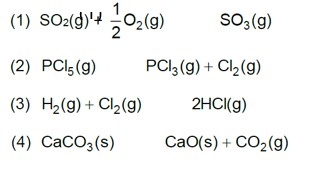7.46. The ionization constant of acetic acid is 1.74 x 10-5. Calculate the degree of dissociation of acetic acid in its 0.05 M solution. Calculate the concentration of acetate ion in the solution and its pH.
7.46. The ionization constant of acetic acid is 1.74 x 10-5. Calculate the degree of dissociation of acetic acid in its 0.05 M solution. Calculate the concentration of acetate ion in the solution and its pH.
-
1 Answer
-
The dissociation equilibrium is
CH3? COOH? CH3? COO− + H+.
Let α be the degree of dissociation.
The equilibrium concentrations of CH3? COOH, CH3COO− and H+ are c (1−α), c (α) and c (α) respectively.
The equilibrium constant expression is Kc? = [CH3? COO−] [H+]? / [CH3? COOH].Kc? = (cα) (cα) / c (1−α)? ≈cα2
α= (Ka? / c)1/2? = (1.74×10−5 / 0.05)1/2?
=1.865×10−2
[CH3? CO−]= [H+]= cα= 0.05×1.865×10−2= 9.33×10−4M
pH= −log [H+]...more
Similar Questions for you
0.01 M NaOH,
M = 1 * 10-2

pOH = 2
pH = 2
Kp = Kc (RT)Dng
36 * 10–2 = Kc (0.0821 * 300)–1
Kc = 0.36 * 0.0821 * 300 = 8.86 » 9
A(g) ->B(g) + (g)
Initial moles n 0 0
Eqb. moles n(1 – a) na
total moles =
Eqb. pressure
On increasing pressure, equilibrium moves in that direction where number of gaseous moles decreases.
Taking an Exam? Selecting a College?
Get authentic answers from experts, students and alumni that you won't find anywhere else
Sign Up on ShikshaOn Shiksha, get access to
- 65k Colleges
- 1.2k Exams
- 679k Reviews
- 1800k Answers


